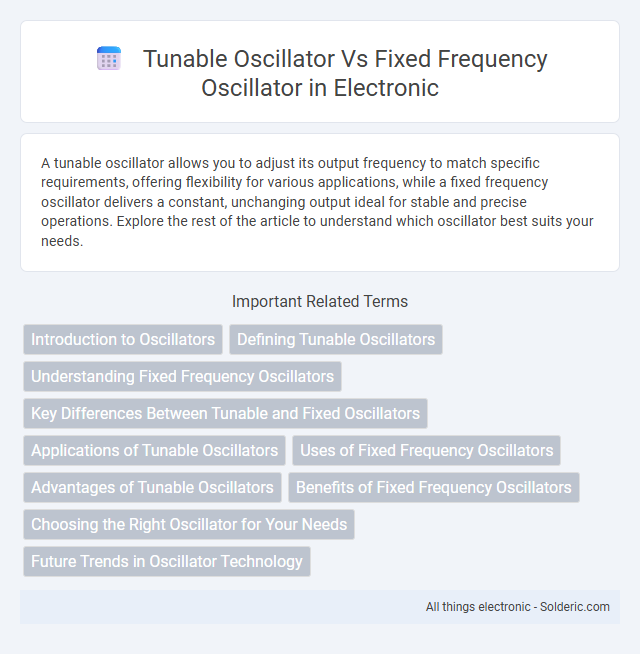A tunable oscillator allows you to adjust its output frequency to match specific requirements, offering flexibility for various applications, while a fixed frequency oscillator delivers a constant, unchanging output ideal for stable and precise operations. Explore the rest of the article to understand which oscillator best suits your needs.
Comparison Table
| Feature | Tunable Oscillator | Fixed Frequency Oscillator |
|---|---|---|
| Frequency Adjustment | Variable frequency output, can be adjusted as needed | Constant frequency output, no adjustment possible |
| Applications | Signal generation, clock synthesis, communication systems requiring flexibility | Timing references, clock sources, stable frequency applications |
| Complexity | More complex circuitry due to tuning mechanisms | Simpler design, fewer components |
| Cost | Generally higher due to tunability features | Lower cost due to fixed design |
| Stability | Potentially less stable frequency due to tuning | High frequency stability and accuracy |
| Examples | Voltage-Controlled Oscillators (VCO), Phase-Locked Loop (PLL) oscillators | Crystal Oscillators, MEMS Oscillators |
Introduction to Oscillators
Oscillators are essential electronic components that generate periodic waveforms used in various applications, and they are classified mainly into tunable oscillators and fixed frequency oscillators. Tunable oscillators allow adjustable output frequencies, enabling flexibility for tasks such as communication systems and signal processing, whereas fixed frequency oscillators provide a stable, constant frequency ideal for precise timing and clock generation. Understanding the differences between these types is critical for selecting the appropriate oscillator based on the specific frequency stability and adjustability requirements of an electronic circuit.
Defining Tunable Oscillators
Tunable oscillators allow adjustment of their output frequency within a specified range, enabling customization for varying applications such as communication systems, signal generators, and frequency synthesis. Fixed frequency oscillators produce a constant, unchanging frequency ideal for reference clocks and stable timing sources where precision and stability are critical. Your choice between tunable and fixed frequency oscillators depends on whether flexibility in frequency selection or unwavering stability is paramount for your design requirements.
Understanding Fixed Frequency Oscillators
Fixed frequency oscillators generate a stable, unchanging signal at a predetermined frequency, providing consistent and reliable timing references in electronic circuits. Common examples include crystal oscillators and ceramic resonators, which rely on precise physical properties to maintain frequency stability. Their fixed nature ensures minimal frequency drift, making them ideal for applications requiring exact timing, such as clocks, microprocessors, and communication systems.
Key Differences Between Tunable and Fixed Oscillators
Tunable oscillators allow adjustment of their output frequency within a specified range, providing flexibility for applications requiring frequency modulation or calibration. Fixed frequency oscillators generate a stable signal at a single, predefined frequency, offering simplicity and consistent performance ideal for systems needing constant frequency reference. Your choice depends on whether frequency adaptability or stability is more critical for the intended electronic design or communication system.
Applications of Tunable Oscillators
Tunable oscillators are widely used in wireless communication systems, signal generators, and frequency synthesis where frequency agility is essential. These oscillators enable dynamic frequency selection for applications such as software-defined radios, radar systems, and adaptive filters. Their adjustability supports optimized system performance across multiple frequency bands, enhancing flexibility in modern electronic devices.
Uses of Fixed Frequency Oscillators
Fixed frequency oscillators are commonly used in applications requiring a stable and precise reference signal, such as clock generation in digital circuits, communication systems, and instrumentation. They provide consistent output frequencies critical for synchronization in microprocessors, radio transmitters, and signal processing devices. Their reliability and stability make them essential in environments where frequency drift can significantly impact system performance.
Advantages of Tunable Oscillators
Tunable oscillators offer significant advantages in applications requiring frequency agility and precision, enabling dynamic adjustment to different signal environments. They provide versatility for wideband communication systems, facilitating frequency hopping and spectrum management without hardware changes. Compared to fixed frequency oscillators, tunable variants enhance system adaptability, reduce inventory costs, and support multi-band operation in modern wireless devices.
Benefits of Fixed Frequency Oscillators
Fixed frequency oscillators provide high stability and precise signal generation, making them ideal for applications requiring consistent frequency output such as clock signals in digital circuits. Their simplicity reduces the risk of frequency drift and electromagnetic interference, enhancing overall system reliability. Choosing a fixed frequency oscillator ensures your design benefits from lower phase noise and predictable performance in critical timing applications.
Choosing the Right Oscillator for Your Needs
Tunable oscillators offer adjustable frequency output, making them ideal for applications requiring flexibility and precise frequency control, such as communication systems and signal testing. Fixed frequency oscillators provide stable and consistent output at a predetermined frequency, benefiting applications where reliability and low phase noise are critical. Your choice depends on whether you need adaptability for varying frequencies or steady output for specialized operational environments.
Future Trends in Oscillator Technology
Tunable oscillators are increasingly favored over fixed frequency oscillators due to their adaptability in dynamic communication systems and IoT applications, where frequency agility enhances performance and energy efficiency. Advances in MEMS and integrated silicon-based oscillators enable precise tuning with minimal power consumption, driving innovation in 5G, autonomous vehicles, and wearable devices. Your choice of oscillator technology will significantly impact future-proofing electronic designs as demand grows for highly stable, low-phase-noise, and frequency-agile components.
Tunable oscillator vs Fixed frequency oscillator Infographic

 solderic.com
solderic.com